
An aircraft is a vehicle that is able to fly by gaining support from the air. It counters the force of gravity by using either static lift or the dynamic lift of an airfoil, or, in a few cases, direct downward thrust from its engines. Common examples of aircraft include airplanes, helicopters, airships, gliders, paramotors, and hot air balloons.

A wing is a type of fin that produces lift while moving through air or some other fluid. Accordingly, wings have streamlined cross-sections that are subject to aerodynamic forces and act as airfoils. A wing's aerodynamic efficiency is expressed as its lift-to-drag ratio. The lift a wing generates at a given speed and angle of attack can be one to two orders of magnitude greater than the total drag on the wing. A high lift-to-drag ratio requires a significantly smaller thrust to propel the wings through the air at sufficient lift.

A fixed-wing aircraft is a heavier-than-air flying machine, such as an airplane, which is capable of flight using wings that generate lift caused by the aircraft's forward airspeed and the shape of the wings. Fixed-wing aircraft are distinct from rotary-wing aircraft, and ornithopters. The wings of a fixed-wing aircraft are not necessarily rigid; kites, hang gliders, variable-sweep wing aircraft and airplanes that use wing morphing are all examples of fixed-wing aircraft.

Flight or flying is the process by which an object moves through a space without contacting any planetary surface, either within an atmosphere or through the vacuum of outer space. This can be achieved by generating aerodynamic lift associated with gliding or propulsive thrust, aerostatically using buoyancy, or by ballistic movement.
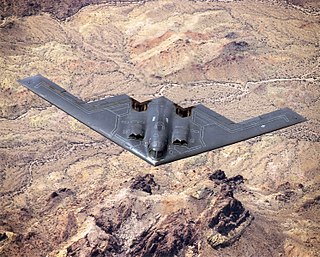
A flying wing is a tailless fixed-wing aircraft that has no definite fuselage, with its crew, payload, fuel, and equipment housed inside the main wing structure. A flying wing may have various small protuberances such as pods, nacelles, blisters, booms, or vertical stabilizers.
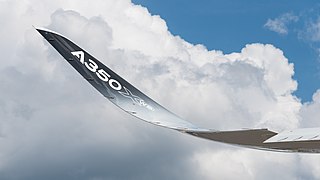
Wingtip devices are intended to improve the efficiency of fixed-wing aircraft by reducing drag. Although there are several types of wing tip devices which function in different manners, their intended effect is always to reduce an aircraft's drag. Wingtip devices can also improve aircraft handling characteristics and enhance safety for following aircraft. Such devices increase the effective aspect ratio of a wing without greatly increasing the wingspan. Extending the span would lower lift-induced drag, but would increase parasitic drag and would require boosting the strength and weight of the wing. At some point, there is no net benefit from further increased span. There may also be operational considerations that limit the allowable wingspan.
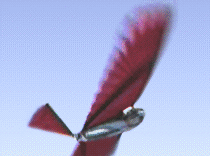
An ornithopter is an aircraft that flies by flapping its wings. Designers sought to imitate the flapping-wing flight of birds, bats, and insects. Though machines may differ in form, they are usually built on the same scale as flying animals. Larger, crewed ornithopters have also been built and some have been successful. Crewed ornithopters are generally either powered by engines or by the pilot.
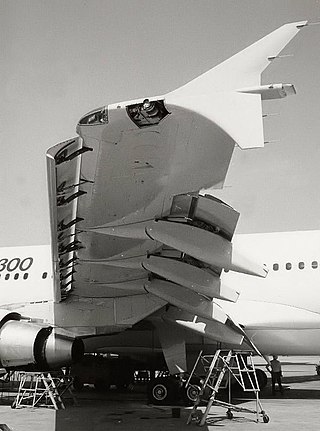
A flap is a high-lift device used to reduce the stalling speed of an aircraft wing at a given weight. Flaps are usually mounted on the wing trailing edges of a fixed-wing aircraft. Flaps are used to reduce the take-off distance and the landing distance. Flaps also cause an increase in drag so they are retracted when not needed.

A paper plane is a toy aircraft, usually a glider made out of single folded sheet of paper or paperboard. A simple nose-heavy paper plane, thrown like a dart, is also known as a paper dart.

An airplane, or aeroplane, informally plane, is a fixed-wing aircraft that is propelled forward by thrust from a jet engine, propeller, or rocket engine. Airplanes come in a variety of sizes, shapes, and wing configurations. The broad spectrum of uses for airplanes includes recreation, transportation of goods and people, military, and research. Worldwide, commercial aviation transports more than four billion passengers annually on airliners and transports more than 200 billion tonne-kilometers of cargo annually, which is less than 1% of the world's cargo movement. Most airplanes are flown by a pilot on board the aircraft, but some are designed to be remotely or computer-controlled such as drones.

A blended wing body (BWB), also known as blended body, hybrid wing body (HWB) or a lifting aerofoil fuselage, is a fixed-wing aircraft having no clear dividing line between the wings and the main body of the craft. The aircraft has distinct wing and body structures, which are smoothly blended together with no clear dividing line. This contrasts with a flying wing, which has no distinct fuselage, and a lifting body, which has no distinct wings. A BWB design may or may not be tailless.

An oblique wing is a variable geometry wing concept. On an aircraft so equipped, the wing is designed to rotate on center pivot, so that one tip is swept forward while the opposite tip is swept aft. By changing its sweep angle in this way, drag can be reduced at high speed without sacrificing low speed performance. This is a variation on the classic swing-wing design, intended to simplify construction and retain the center of gravity as the sweep angle is changed.
Gliding flight is heavier-than-air flight without the use of thrust; the term volplaning also refers to this mode of flight in animals. It is employed by gliding animals and by aircraft such as gliders. This mode of flight involves flying a significant distance horizontally compared to its descent and therefore can be distinguished from a mostly straight downward descent like a round parachute.

A closed wing is a wing that effectively has two main planes which merge at their ends so that there are no conventional wing tips. Closed wing designs include the annular wing, the joined wing, the box wing and spiroid tip devices.

A glider is a fixed-wing aircraft that is supported in flight by the dynamic reaction of the air against its lifting surfaces, and whose free flight does not depend on an engine. Most gliders do not have an engine, although motor-gliders have small engines for extending their flight when necessary by sustaining the altitude with some being powerful enough to take off by self-launch.

In aeronautics, a tailless aircraft is an aircraft with no other horizontal aerodynamic surface besides its main wing. It may still have a fuselage, vertical tail fin, and/or vertical rudder.

Washout is a characteristic of aircraft wing design which deliberately reduces the lift distribution across the span of an aircraft’s wing. The wing is designed so that the angle of incidence is greater at the wing roots and decreases across the span, becoming lowest at the wing tip. This is usually to ensure that at stall speed the wing root stalls before the wing tips, providing the aircraft with continued aileron control and some resistance to spinning. Washout may also be used to modify the spanwise lift distribution to reduce lift-induced drag.
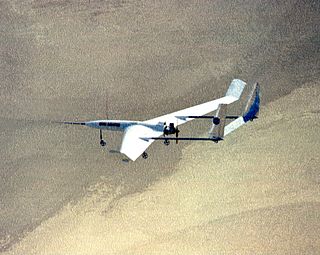
A Mars aircraft is a vehicle capable of sustaining powered flight in the atmosphere of Mars. So far, the Mars helicopter Ingenuity is the only object to ever fly on Mars, completing 52 successful flights covering 12.168 km (7.561 mi) in 1 hour, 33 minutes and 45 seconds of flight time.
Aerodynamics is a branch of dynamics concerned with the study of the motion of air. It is a sub-field of fluid and gas dynamics, and the term "aerodynamics" is often used when referring to fluid dynamics

Towed glider air-launch system is a NASA-designed two-stage air-launched reusable launch system currently in development at NASA's Armstrong Flight Research Center. The system uses a glider, tow plane, and rocket and is designed to carry small satellites to orbit. Both the glider and tow plane are reusable.





















